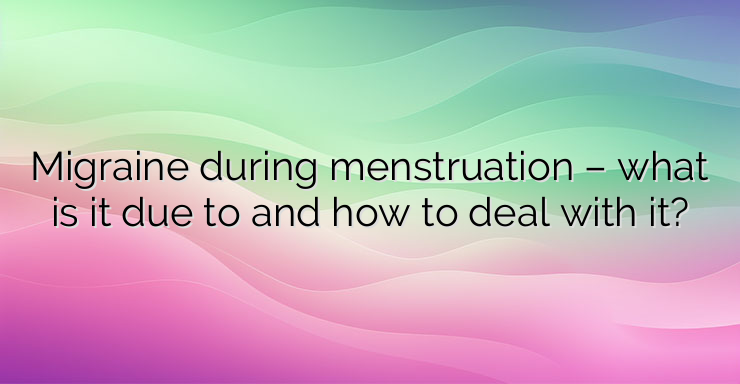Migraine is a neurological disorder that affects about 10-20% of the population, more often women. Menstruation is a period of a woman’s menstrual cycle during which, due to changes in the levels of female sex hormones, an attack can be triggered in about 70% of women who suffer from migraine. The condition is quite unpleasant because it affects the normal lifestyle of women during this period. For this reason, the correct approach in its treatment is of utmost importance. There are two main types of migraine – with aura and without aura. There is a greater frequency of patients suffering from migraine without aura, which is characterized by a unilateral throbbing headache that can be accompanied by nausea, vomiting, photophobia and other ailments. It is characteristic of migraine with aura that 24 hours before its onset, the headache is preceded by neurological symptoms – the so-called aura. Neurological symptoms are characterized by speech, visual, sensory and/or motor disturbances preceding the migraine attack. The pathogenetic mechanism of occurrence of migraine headaches is related to irritation of the trigeminus, which causes the release of vasodilator substances – calcitonin gene-related peptide, neurokinin A, substance P, which have a powerful vasodilator effect on intracerebral vessels. As a result, plasma extravasation and perivascular edema occur, which lead to activation of nociceptors (pain receptors). More specific from an etiological point of view is the migraine that occurs during menstruation. According to the third edition of the International Classification of Headache Disorders, there are two types of menstrual migraine: 1. The so-called. “pure migraine” – starts 1-2 days before the expected date of menstruation and lasts up to 3 days after the first day of menstruation. Characteristic of this type of migraine is that it is without aura and does not occur outside of the period of menstruation; 2. Migraine associated with menstruation with onset again 1-2 days before menstruation up to 3 days after its onset. What is different about this type of migraine is that it occurs at other times of the month besides the menstrual period. The reason for the occurrence of migraines during menstruation is related to the fluctuation in the levels of estrogens and progesterone. During the late luteal phase, estrogen levels are low, which is also associated with the onset of a migraine attack. Triggering of a migraine attack is also observed in patients on oral contraceptives in the week when they take placebo tablets – i.e. the main cause of migraines during this period is estrogen withdrawal. This thesis is confirmed by the fact that during pregnancy, when estrogen levels are significantly increased, pregnant women less often complain of severe headaches and migraine attacks. On the other hand, with the onset of menopause, the secretion of estrogens decreases sharply, which is why during this period women complain of severe migraines. Characteristic of menstrual migraine is that the headache is unilateral,stronger than ordinary migraine attacks, accompanied by nausea and vomiting. Female patients prefer to isolate themselves in dark, quiet rooms due to photophobia. What are the medication solutions? There are several classes of medications to treat migraine attacks. The first group of medications are the so-called triptans. They lead to rapid pain relief and are an effective choice for a severe attack. However, they are not recommended for attack prevention. Another group of medications are non-steroidal anti-inflammatory drugs (NSAIDs), which, despite being non-specific for the condition, successfully affect pain. Dihydroergotamine is also a drug used in the treatment of migraines – it is used in very severe cases of migraines, excluding certain contraindications such as ischemic heart disease, pregnancy, etc. For the prevention of migraine attacks, triptans or estrogen preparations can be used for a period of 6-7 days, starting 2 days before the expected date of menstruation. In women with an irregular monthly cycle, prevention is impossible and ineffective. Another type of therapy is the so-called noninvasive nerve stimulation. Special devices are attached to the shoulder, neck or head, and the patient himself can send nerve impulses to the n.vagus through the device to relieve pain. For the prevention of migraine during menstruation, intake of magnesium is also recommended; maintaining low levels of glutamate in the body, as it has been found to be one of the triggers of a migraine attack; intake of foods rich in fiber and beneficial fatty acids; peaceful and full sleep. Menstrual migraine is an unpleasant condition that can be well controlled with the right medication and lifestyle changes.vagus on the pain relief device. For the prevention of migraine during menstruation, intake of magnesium is also recommended; maintaining low levels of glutamate in the body, as it has been found to be one of the triggers of a migraine attack; intake of foods rich in fiber and beneficial fatty acids; peaceful and full sleep. Menstrual migraine is an unpleasant condition that can be well controlled with the right medication and lifestyle changes.vagus on the pain relief device. For the prevention of migraine during menstruation, intake of magnesium is also recommended; maintaining low levels of glutamate in the body, as it has been found to be one of the triggers of a migraine attack; intake of foods rich in fiber and beneficial fatty acids; peaceful and full sleep. Menstrual migraine is an unpleasant condition that can be well controlled with the right medication and lifestyle changes.


Leave a Reply